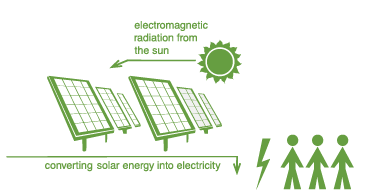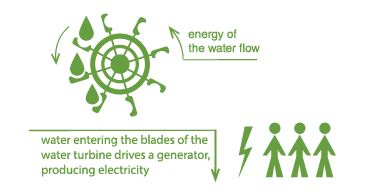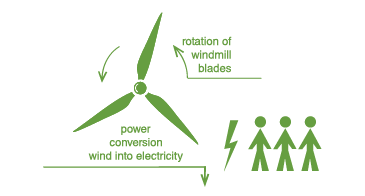
Solar Energy Basics
Solar is the Latin word for sun—a powerful source of energy that can be used to heat, cool, and light
our homes, businesses and communities. That's because more energy from the sun falls on the earth in
one hour than is used by everyone in the world in one year. A variety of technologies convert sunlight
to usable energy for buildings. The most commonly used solar technologies for homes and businesses are
solar photovoltaics for electricity, solar water heating and passive solar design for space heating
and cooling.
Homes, businesses and industry also use these technologies to diversify their energy sources, improve
efficiency, and save money. Solar photovoltaic and concentrating solar power technologies are also being
used by developers and utilities to produce electricity on a massive scale to power cities and small towns.
Learn more about the following solar technologies:
Solar Photovoltaic Technology Basics
Solar cells, also called photovoltaic (PV) cells by scientists, convert sunlight directly into electricity.
The PV effect was discovered in 1954, when scientists at Bell Telephone discovered that silicon (an
element found in sand) created an electric charge when exposed to sunlight. Soon solar cells were being
used to power space satellites and smaller items like calculators and watches.
Traditional solar cells are made from silicon, are usually flat-plate, and generally are the most efficient.
Second-generation solar cells are called thin-film solar cells because they are made from amorphous
silicon or nonsilicon materials such as cadmium telluride. Thin film solar cells use layers of
semiconductor materials only a few micrometers thick. Because of their flexibility, thin film solar
cells can double as rooftop shingles and tiles, building facades, or the glazing for skylights.
Third-generation solar cells are being made from a variety of new materials besides silicon, including
solar inks using conventional printing press technologies, solar dyes, and conductive plastics. Some
new solar cells use plastic lenses or mirrors to concentrate sunlight onto a very small piece of high
efficiency PV material. The PV material is more expensive, but because so little is needed, these systems
are becoming cost effective for use by utilities and industry. However, because the lenses must be pointed
at the sun, the use of concentrating collectors is limited to the sunniest parts of the country.

Hydropower Basics
Hydropower technologies generate power by using a dam or diversion structure to alter the natural
flow of a river or other body of water. Hydropower facilities come in all sizes. Some may be very
large, but they can be tiny too, taking advantage of water flows in municipal water facilities or
irrigation ditches. They can even be “dam-less,” with diversions or run-of-river facilities that
channel part of a stream through a powerhouse before the water rejoins the main river. Whatever
the method, hydroelectric power is much easier to obtain and more widely used. Nigeria has 3
hydropower plants (Kanji, Jebba, Shiroro and Zamfara) which have proved very effective in providing
much needed capacity.

Wind Energy Basics
Wind energy has been harnessed for hundreds of years. From windmills used for pumping water or grinding
grain. Today, the windmill's modern equivalent—a wind turbine—can use the wind's energy to generate electricity.
Wind turbines, like windmills, are mounted on a tower to capture the most energy. At 100 feet (30 meters)
or more above ground, they can take advantage of the faster and less turbulent wind. Turbines catch the wind's
energy with their propeller-like blades. Usually, two or three blades are mounted on a shaft to form a rotor.
A blade acts much like an airplane wing. When the wind blows, a pocket of low-pressure air forms on the
downwind side of the blade. The low-pressure air pocket then pulls the blade toward it, causing the
rotor to turn. This is called lift. The force of the lift is actually much stronger than the wind's
force against the front side of the blade, which is called drag. The combination of lift and drag
causes the rotor to spin like a propeller, and the turning shaft spins a generator to make electricity.



